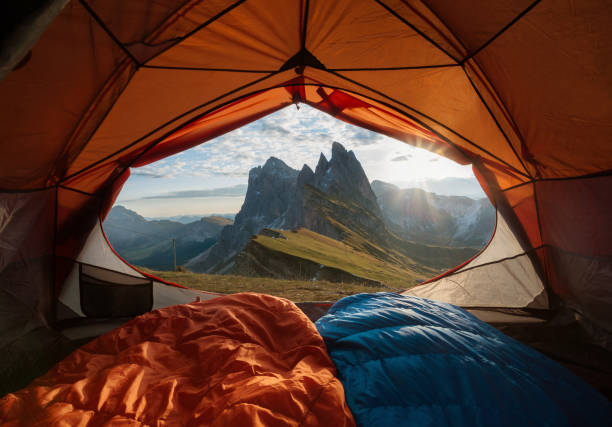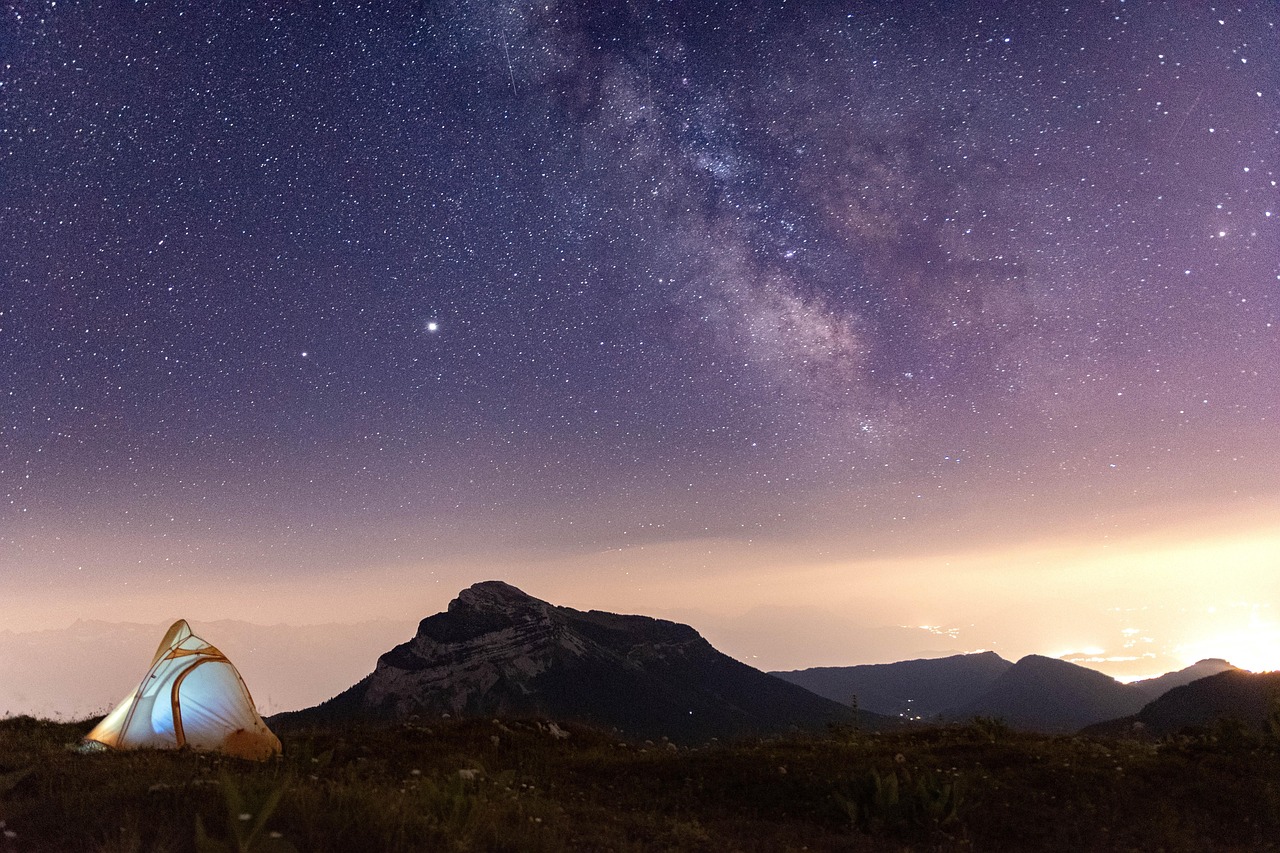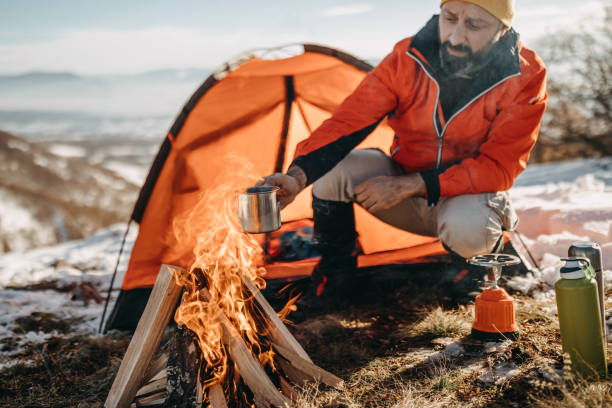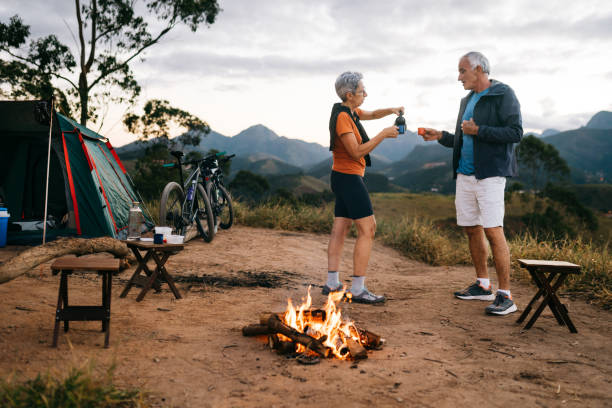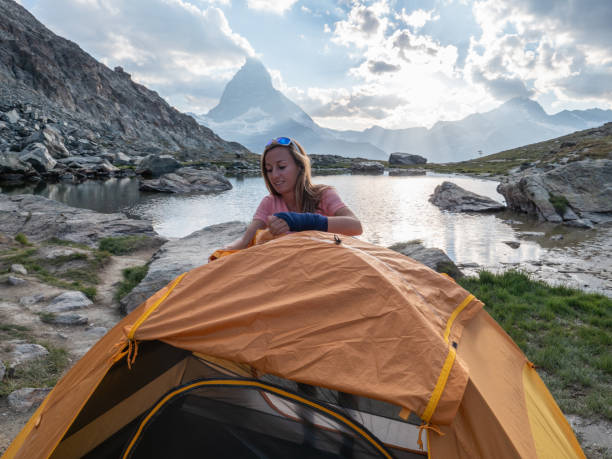Getting into camping can be one of the most rewarding decisions you’ll ever make—fresh air, quiet mornings, s’mores under the stars—but let’s be real, your tent can make or break the experience. When we first got started, we were totally overwhelmed by the options available as best camping tents for beginners. Do you go with dome-style or cabin-style? Fiberglass poles or aluminum? And what in the world is a “no-see-um mesh”?
If you’re a beginner, you don’t need all the bells and whistles (yet), but you do need a tent that’s reliable, easy to pitch, and built to handle a surprise rainstorm or two. We’ve spent the last year testing tents in the wild—literally—and we’ve come up with a list of the 7 best starter tents. These are all tents we’ve personally used on hikes, car camping trips, and beach getaways. Let’s start with four of them, with the rest coming right up in our next update!
Table of Contents
- Coleman 2-Person Dome Tent
- Kelty Wireless Tent
- Eureka Family Camping Tent
- Coleman 4-Person Tent
- The North Face 4P Tent
- UNP Family Camping Tent
- EVER ADVANCED Camping Tent
- Our Verdict!
- How to Choose the Best Camping Tents for Beginners
- Easy Setup
- Weather Protection
- Interior Space & Comfort
- What is a good beginner tent?
- How to choose a camping tent?
- What is the best material for a tent?
7
Coleman 2-Person Dome Tent
We took the Coleman 2-Person Dome Tent on a quick weekend getaway to the Ozarks. It was just the two of us, our backpacks, and this compact little tent that didn’t look like much when it came out of the bag—but it seriously impressed us.
Setup was a breeze. Coleman claims 10 minutes, but we had it standing in under 5 after a quick glance at the instructions. The pre-attached poles basically guide you through the process. We sealed the seams with Coleman’s seam sealer, per a tip from other campers, and it held up beautifully.
That night, we were hit with an unexpected downpour. We’re talking torrential, sideways rain from about 10 PM to breakfast. And guess what? Not a single drop inside. Okay, one drop—through the unzipped E-port where we forgot to close the flap. Our bad! But everything else stayed bone dry thanks to the inverted seams, welded corners, and rainfly.
Ventilation was also surprisingly good. We kept the ground vent and windows open the whole time and didn’t feel stuffy at all. With a 7 x 5 ft footprint and 4 ft center height, it fit a queen-size air mattress snugly. It’s a tight fit for two, but perfect if you pack light. Bonus points for the E-port that let us run a power cord in to charge our phones.
We didn’t expect to love a budget tent this much, but for the price, it’s a no-brainer. Lightweight, weatherproof, easy to pitch—it’s everything that a best tent for beginners should be.
Browse through the official website of Coleman for more interesting options!
Pros:
- Quick and easy setup in under 5 minutes
- Extra-tall center height allows standing room
- Strong wind resistance with pre-attached poles
Cons:
- Limited ventilation in hot weather due to minimal mesh
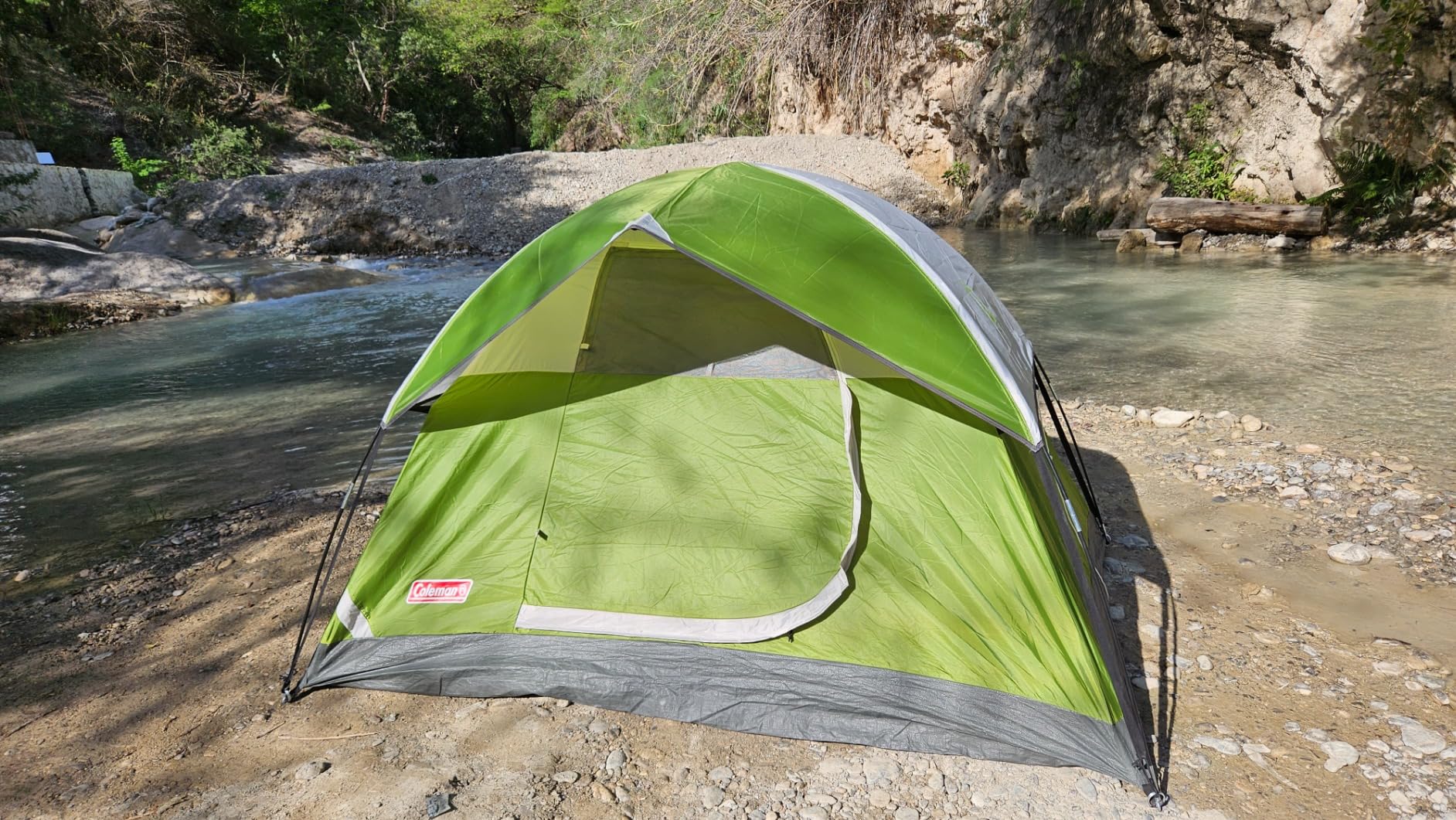
6
Kelty Wireless Tent
For our annual kayak camping trip along the Wisconsin River, we brought the Kelty Wireless Tent—and we’re glad we did. It’s one of those tents that instantly feels like a little home base.
This tent’s freestanding design was a game-changer on sandy terrain. The fiberglass and hybrid poles felt sturdy in the wind, especially with the sleeves near the base that lock them in tight. It felt rock solid even when the river breeze picked up at night.
The two vestibules were a lifesaver. We stuffed all our wet gear—life vests, muddy shoes, and backpacks—into the side vestibules and kept the sleeping area clean. Speaking of space, the 70 sq. ft. floor felt super roomy for two people. There are two doors, which meant no climbing over each other for midnight bathroom runs. Always a plus.
We left the rainfly off the first night to stargaze through the no-see-um mesh. The view was magical, even though the poles slightly obstructed the sky. Still, the tent offered great privacy and kept sand out better than we expected. Inside, there were mid-height storage pockets and loops to hang a light and rig up a mini clothesline for drying out our socks.
Setup was easy, except for the footprint—it’s a bit smaller than the tent and connects in a funky way. Took some fiddling, but once we figured it out, the whole thing packed up easily. This tent isn’t ultra-light, but it was manageable even with our kayak load. A rock-solid option for best beginner backpacking tent for enthusiasts wanting durability, comfort, and good airflow.
P.S. You may also be interested in our exclusive roundup of the best all weather camping tents. Aren’t you?
Pros:
- Instant pop-up design saves time and effort
- Lightweight and compact for easy carrying
- Dual door and mesh window setup improves airflow
Cons:
- Less durable in heavy rain or wind due to lightweight build
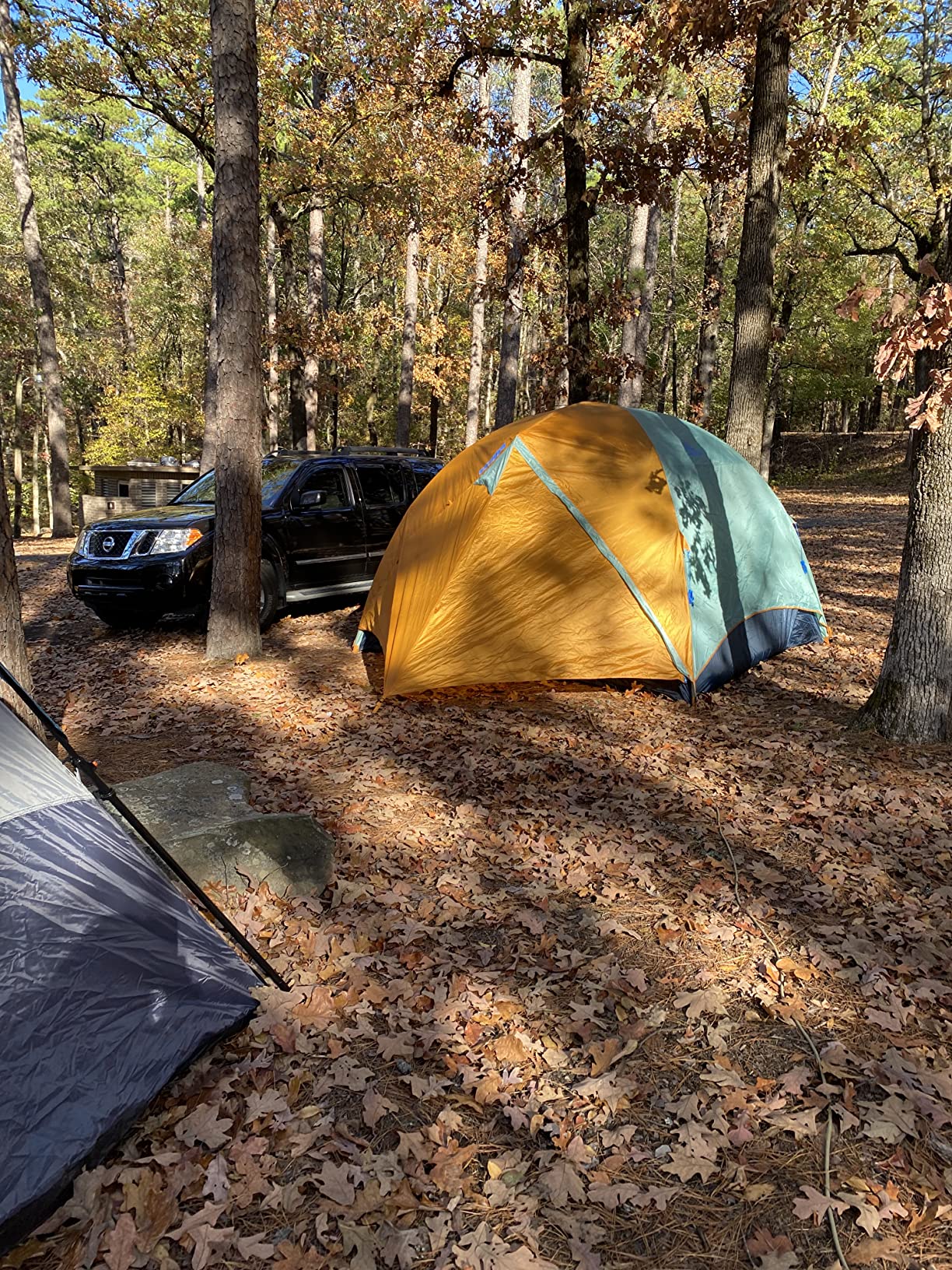
5
Eureka Family Camping Tent
Best Durability. When we went car camping with the kids at Devil’s Lake State Park, we wanted something spacious, tall, and family-friendly. Enter the Eureka Family Camping Tent. This tent felt like a tiny cabin in the woods—seriously, we could stand up straight and stretch without touching the ceiling.
The steep walls and 7-foot height made it super comfortable for changing clothes and moving around. We fit a queen-size mattress, a twin roll, and still had enough room for our gear and a little play area for the kids.
Set up took two of us about 15 minutes. It’s not the fastest tent to pitch, but once you get the pole sleeves and corner hubs in place, it stands strong. The mix of steel and fiberglass poles gave it a really stable frame. Plus, the extended fly over the door kept the entry dry during a drizzly morning.
What we really loved were the smart little features. The large mesh windows had waterproof curtains, so we could open them for ventilation without worrying about surprise rain. There were gear lofts to keep flashlights and toys off the ground. And the E! Powerport let us run a cord in so we could plug in a fan and charge devices. The kids even watched a movie before bed one night—glamping at its finest!
If you’re looking for a family tent that balances comfort and weather protection, the Eureka Copper Canyon LX 4 is a winner. Just be aware—it’s a bit bulky and best suited for car camping.
Feel free to check out this review by Little Campfires on YouTube!
Pros:
- Large double-layer design for better insulation and waterproofing
- Full mesh ceiling for stargazing and airflow
- Strong fiberglass and aluminum poles provide stability
Cons:
- On the heavier side for a 4-person tent
4
Coleman 4-Person Tent
This tent completely changed how we camp in the summer. We took the Coleman 4-Person Tent out to Joshua Tree in peak sun season, and the Dark Room Technology was a total lifesaver. For once, we didn’t wake up sweating at 6 AM.
Setup was ridiculously fast. With pre-attached poles, it took us less than 10 minutes, and that was our first time using it. The wide door made it easy to get our queen-size airbed inside without awkward wrestling. And the extra headroom? Huge upgrade from a regular dome tent—no more bumping our heads every time we sat up.
But the real highlight was how dark and cool the tent stayed. It blocked out 90% of the sunlight, which gave us the freedom to sleep in, nap midday, or just escape the harsh desert heat. The ventilation was on point, and even with the mesh roof covered by the rainfly, airflow felt natural.
One thing we noticed was how well the tent held up to wind. We had some gusts up to 30 mph and it didn’t budge. The weather-resistant floor and inverted seams kept things dry when a sudden desert sprinkle hit.
Packing it down was a bit of a puzzle the first time, especially with the attached poles. But after a couple of tries, we figured out the fold and roll technique and got it to fit back into the carry bag.
If you’re someone who loves the outdoors but not the blazing sun, this is the beginner backpacking tent for you. Easy, comfortable, and shockingly cool inside. Total game changer.
Pros:
- Spacious enough for 3 queen air mattresses
- Excellent ventilation with multiple mesh windows
- Durable 185T polyester fabric resists rain
Cons:
- Not ideal for solo campers or quick overnights due to its size
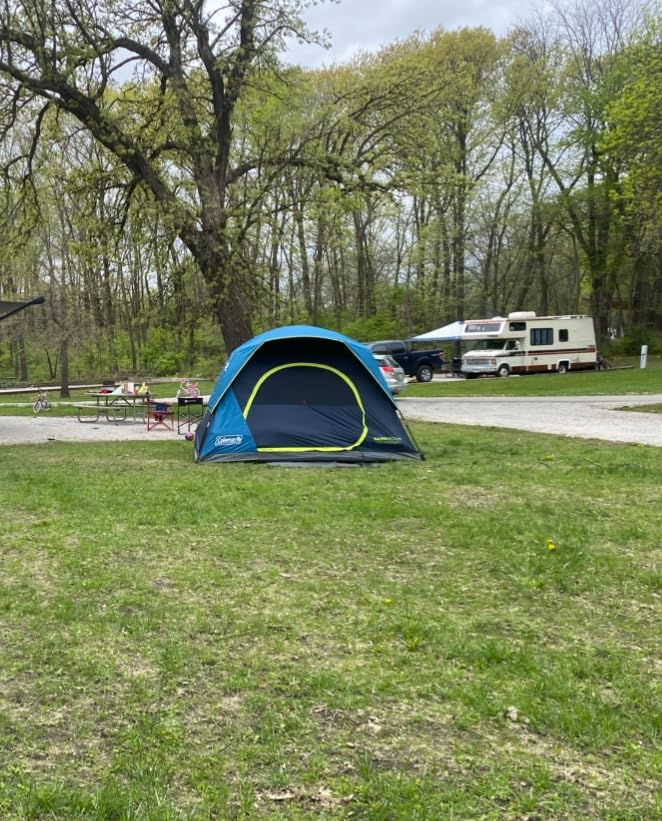
3
The North Face 4P Tent
We took the The North Face 4P Tent out on a late spring trip to the Olympic Peninsula, a place where it can be sunny one minute and raining sideways the next. We needed a tent that could handle the unpredictable Pacific Northwest weather and make car camping feel easy. The North Face Wawona 4 delivered on both fronts—and then some.
First off, setup is almost laughably simple. Three poles—color-coded—and you’re done in under five minutes, even if it’s your first time. One trick we learned: lay the tent flat and run both main poles through the sleeves before inserting them into the corners. That way, they form an X across the top and create a strong foundation. The third pole arches over the front to create a massive vestibule, perfect for stashing muddy boots or cooking under in the rain.
And yes, that vestibule is a game changer. With two zippered doors and tons of space, it felt like a covered porch. We stored our cooler, gear, and even sat out there drinking coffee while the rain pattered around us. Inside, it’s surprisingly roomy thanks to the pre-bent poles that stretch the walls nearly vertical. At 5’11″, one of us could stand fully upright in the middle without brushing the ceiling—no crouching necessary.
The two oversized windows brought in tons of light and airflow during the day, and the mesh design kept condensation away even on wet nights. When zipped up with the rainfly, the tent was totally sealed and stayed dry through two stormy nights. No leaks, no drips—just warm, dry sleep.
Packing it down was as easy as setup, thanks to the duffel-style stuff sack. Everything slid in without a wrestling match. For couples or small groups wanting a super-durable, weatherproof tent that’s big on livability, the Wawona 4 is worth every penny. It made us excited to car camp more often—rain or shine.
Pros:
- Extremely simple color-coded setup
- Massive vestibule adds versatile outdoor living space
- Tall vertical walls create a roomy, walk-in interior
Cons:
- Premium pricing may be high for occasional campers
2
UNP Family Camping Tent
Best Stability. If you’re heading out with a big group or the whole family in tow, the UNP Family Camping Tent is like bringing a portable lodge with you. We used this tent for a reunion trip to the Black Hills—six adults, two kids, and enough gear to make it feel like we were moving in. Somehow, this tent swallowed it all and still felt spacious.
The dimensions are massive: 18 feet long, 9 feet wide, and over 6.5 feet tall. We fit three queen-size air mattresses inside with walking room between. The best part? No one had to crawl. You can actually walk from one side to the other without hunching over. It instantly felt more like a cabin than a tent.
Setup took about 10 minutes with two people—less if you’ve got a few extra hands. The instructions were crystal clear, and all the parts were high-quality and intuitive. Once up, it held its shape beautifully, even when the wind picked up on the second night. The extended awning on the rainfly helped deflect water away from the doors, and the 185T polyester fabric held strong—no drips, no damp corners.
We especially loved the stargazing factor. With a huge mesh ceiling and large mesh windows on three sides (plus more on both doors), this tent feels open and airy without sacrificing privacy. On clear nights, we laid back and watched the sky without leaving our sleeping bags.
Small details made a big difference too. Storage pockets kept headlamps, snacks, and phones organized. There’s even a pass-through flap for an electric cord, which we used to plug in a fan and charge devices. At just over 23 pounds, it’s not too bulky either—it fit easily in our trunk with room to spare.
For big groups, families, or anyone who wants a reliable tent with room to move, the UNP Family Tent knocks it out of the park. This is the one you bring when you want to camp comfortably.
Do check out the official brand site for a range of fascinating options!
Pros:
- Fits up to 10 people—perfect for group or family trips
- Great ventilation and panoramic mesh ceiling for views
- Rainfly design protects well during storms
Cons:
- Size and weight make it better suited for car camping only
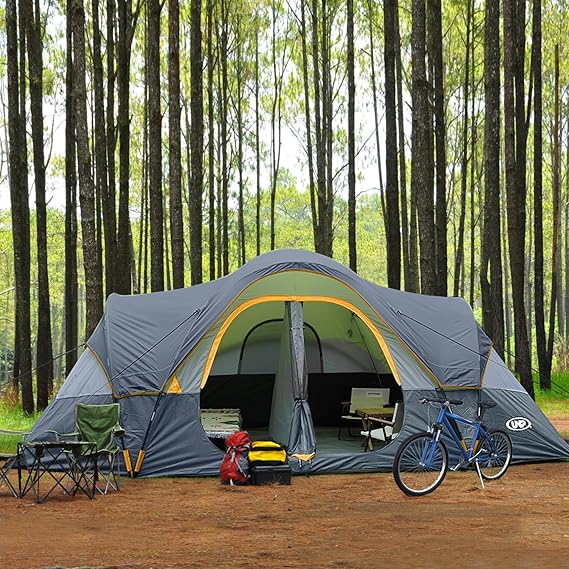
1
EVER ADVANCED Camping Tent
Best Overall. Some tents are a hassle to set up. Others practically pitch themselves. The EVER ADVANCED Camping Tent falls into that glorious second category. We brought this one on a spur-of-the-moment weekend trip and were fully set up—fully—in under 60 seconds. Seriously. One person. No poles to thread. Just unfold, lift, and click the legs into place. That’s it.
This tent was made for campers who want to spend more time enjoying nature and less time fumbling with gear. Once up, the blackout fabric really does its job. With all the windows closed and the rainfly on, it’s pitch black inside—even at midday. It felt like we had our own little cave, perfect for sleeping in past sunrise or getting the kids down early without the evening glow messing up their bedtime.
Ventilation-wise, the tent has three large zippered mesh windows plus a skylight (which we left uncovered one night for stargazing). While the blackout design can retain heat on sunny days, the airflow was solid at night. We did hear from other campers that it heats up quickly in direct sun—especially in darker colorways—so a shady spot or lifting the rainfly a bit helps keep it cooler.
Inside, we had space for a queen air mattress with room left for a suitcase, a soft-sided cooler, and our shoes. With a 9′ x 9′ footprint and 73″ height, it felt roomy enough to stand, stretch, and change comfortably.
The storage options were thoughtful too. Mesh pockets kept our essentials off the floor, and there were loops for hanging a lantern, fan, or even drying socks. The passthrough for power was handy during our second night when we ran a cord in to power a light and a speaker for a cozy evening in.
At just over 22 pounds, the EVER ADVANCED is a great middle ground between quick setup and livable comfort. For solo campers, couples, or small families who want to go from trunk to tent in under a minute, this one is hard to beat. Hands down the best tent for beginners!
Pros:
- 60-second setup with no pole threading
- Blackout fabric offers privacy and sleep comfort
- Spacious interior with full standing height
Cons:
- Heat buildup possible during hot days due to blackout design
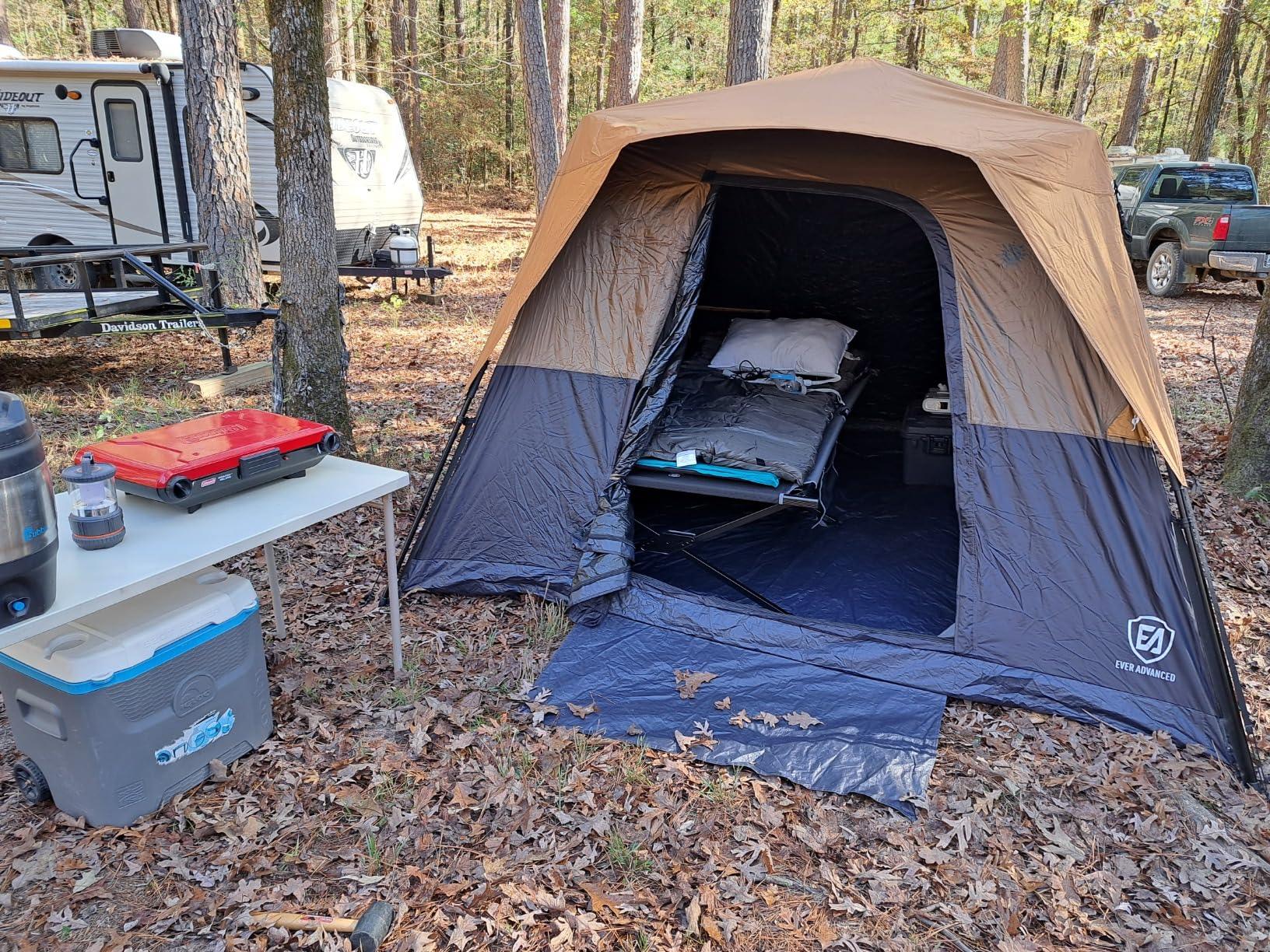
Our Verdict!
We chose the EVER ADVANCED Camping Tent as the Best Overall option from this roundup of the best tent for first time campers. The reason was, of course, its unmatched performance in all seasons and ease of use. However, there are two other options that come as runner-ups in the race given their standout performance in one specific feature. Let’s check them out below.
- Best stability: UNP Family Camping Tent
- Best durability: Eureka Family Camping Tent
How to Choose the Best Camping Tents for Beginners
When we were looking for the best camping tents for beginners, we had a range of important features to look for in mind. However, scrutinizing each feature was taking forever and we needed to narrow down on the key one. This helped us get the best beginner camping tent options without investing time on the time-wasters. So, what were the three key factors we looked out for? See below.
Easy Setup
Why it matters: As a beginner, you don’t want to spend an hour struggling with tent poles and confusing instructions.
Look for:
- Instant or pop-up designs
- Color-coded poles
- Pre-attached frames
These features reduce frustration and get your camp set up fast—even solo.
Weather Protection
Why it matters: Your first camping trip should be fun, not soaked.
Look for:
- Waterproof materials (like polyester with a high PU rating)
- Rainfly coverage
- Strong pole structures that stand up to wind
Even basic car camping can come with surprise weather, so protection is key.
Interior Space & Comfort
Why it matters: Cramped, stuffy tents make for miserable nights—especially if you’re sharing the space.
Look for:
- Standing height or near-vertical walls
- Ventilation (mesh windows, roof vents)
- Storage options like gear lofts or wall pockets
A comfortable interior makes your whole camping experience more enjoyable.
What is a good beginner tent?
A good beginner tent is one that’s simple to pitch, lightweight, and versatile. So, dome and pop-up tents are especially great for first-timers—they often set up in minutes and don’t require complicated instructions. Plus, many come with built-in features like ventilation panels and storage pockets, making the camping experience stress-free and enjoyable.
How to choose a camping tent?
To choose a camping tent, consider how many people will sleep in it, the type of weather you’ll face, and how easy it is to set up. Look for features like waterproof materials, ventilation, and a size that offers enough room for gear and movement. Plus, always match the tent to your trip—car camping allows for bigger tents, while backpacking needs something light and compact.
What is the best material for a tent?
The best material for a tent is polyester—it’s lightweight, quick-drying, and resistant to UV damage, making it ideal for most weather conditions. It’s also more affordable than other fabrics like canvas, without sacrificing durability. For extra protection, look for polyester tents with a PU (polyurethane) coating for added waterproofing.
